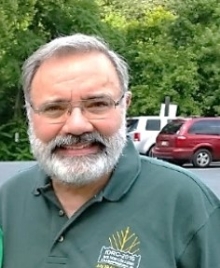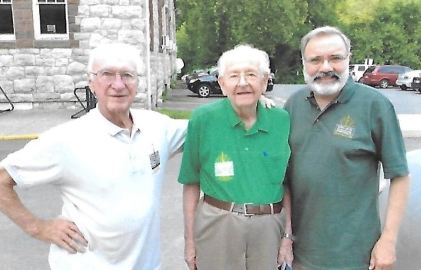
Memories of Karl Norris,
Contribution by Dave Hopkins,
NIR.Consultant @ sbcglobal.net
It is as clear as a movie, we are standing in front of the one of the growth chambers at the Smithsonian Radiation Biology Laboratory, Rockville, MD. It was 1978 and I had invited Karl Norris to bring his own-designed spectroradiometer to measure the lighting in growth chambers I was using to measure the effect of special lighting I set up to mimic ozone depletion on the growth of plants such as peas.
While we were standing there, we were chatting. Only as I think back on it now does it seem remarkable, he pulled out from his papers he had with him an NIR spectrum of ground wheat, and announced that a change at 2180 nm the width of the pen tracing reflected an increase in the protein of 1 percent. He knew that from fourth derivative spectra. Well, I had used fourth derivatives to study UV and visible spectra, but the bands we studied were always discernible by eye. I blurted out, “You’re crazy!” I regretted it as soon as I said it, but he was gracious to ignore it. He went on to say that he knew of a company in Illinois that was looking for a laboratory manager, and I could write to the Vice President of Engineering if I were interested. Well, I did not appreciate that a recommendation from Karl Norris was a shoe-in for the position. I wrote off, and interviewed there. It led to a whole new spectral area and new career for me. At DICKEY-john I met David Funk and a circle of talented engineers. I learned from a number of chemists, and formed a lasting friendship with one of them, Phil Williams. Thanks so much, Karl!
Karl was a master spectroscopist, and it was always a pleasure to meet with him and discuss his latest ideas at the International Diffuse Reflection Conference (IDRC) meetings. I think that the Shootouts were introduced around 1992, and I don’t know for sure whether he won them all, but I think by 1998 he had a long string of presentations that edged out all contenders. I remember that Susan Foulk and I pleaded with Karl not to enter the competition, so others could win. Karl took that to heart, and in 2000 Susan remembers that she won, and in 2002 I finally took home the trophy. At that time the winner was honored by presentation by Fred McClure of a simple plastic trophy. I still display that trophy proudly in my office. It was in a way all due to the humility of Karl Norris.
Fast forward to 2015 or so. I knew that the compiled Fortran program Karl used so well, was no longer supported under the DOS window of Windows 7. I phoned him and asked if I could work with him and I would write Matlab programs to perform the same tasks that his MULR program did. He readily agreed. Bill Hruschka wrote the Fortran program, and Karl sent me the latest documentation, a 1998 version of SPANUSER.DOC by Bill, a 1997 version of MULR.exe, all supporting routines and subroutines, and two data files with 50 scans of ground hard red winter wheat each. I would write a version for Karl and send it to him via Internet, and a version for me, because the directory structure of our computers was different. I called it dqm, for derivative quotient math, because he modestly disliked calling it the “Norris Regression” or “Norris Method”. I remember that he loved the speed of the Matlab program, and would chuckle that it was so fast. We set ourselves the task to make the program automatic, so that one did not need to have the tremendous spectroscopic experience that Karl had. I programmed the method outlined by Bill in SPANUSER, and we obtained the same excellent results Bill reported.
But Karl wanted to know what would happen if we used a different sequence to optimize the gaps and smoothing gaps (smts), so I wrote dqm2 and called the first one dqm1. I wrote dqm3 to perform tasks learn about the spectroscopy of the samples, to plot different derivatives to learn the effects of the size of the gaps and smts. Eventually we combined dqm1, dqm2, dqm3 and other tasks into one dqm program, so that the user of a free, compiled version of the program could get the same experience as the user of the Matlab program, which is not free.
Because Karl always freely shared his program, I will share the Matlab program freely. David Funk suggested that Zoltan Gillay might compile the program for me. I am grateful to Zoltan for his patient help through numerous versions. Karl and I stayed in contact until a few months before he passed away, but a year or two before that he complained that he could not remember how to use the program, or could not remember how to use his email. It was so sad to witness the decay of his fine mind.
I feel very fortunate to have worked with him.

Phil, Karl and I pose at the 2016 IDRC. This picture represents over 250 years on the planet, and about 140 years of experience with NIRS!





